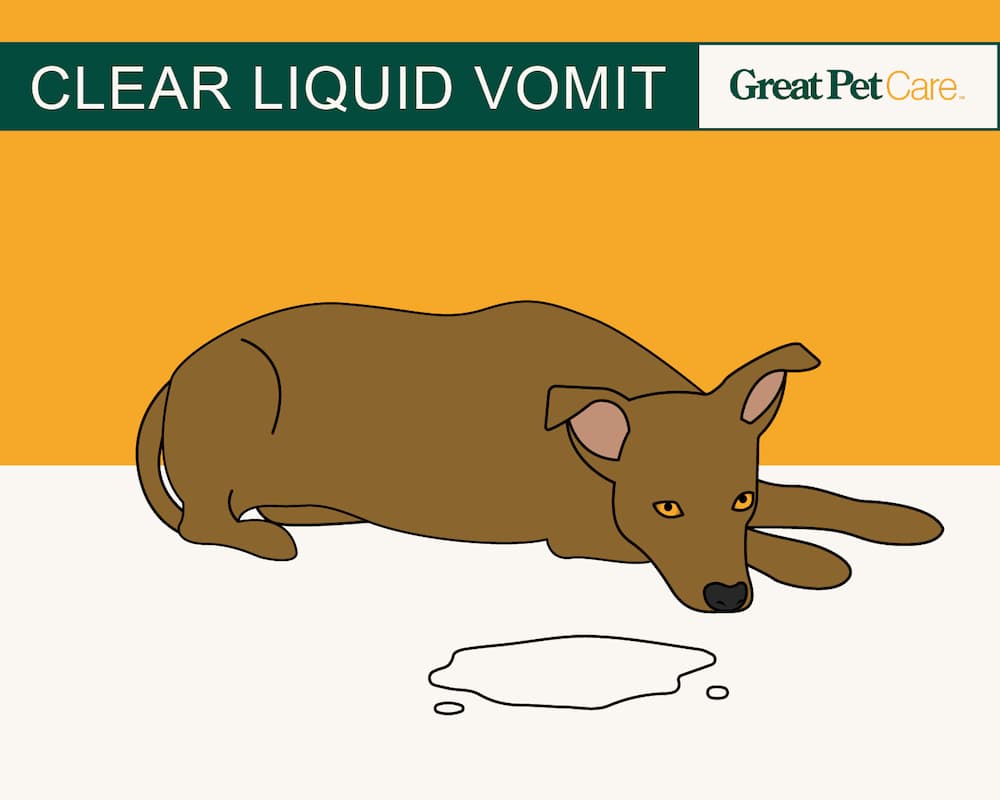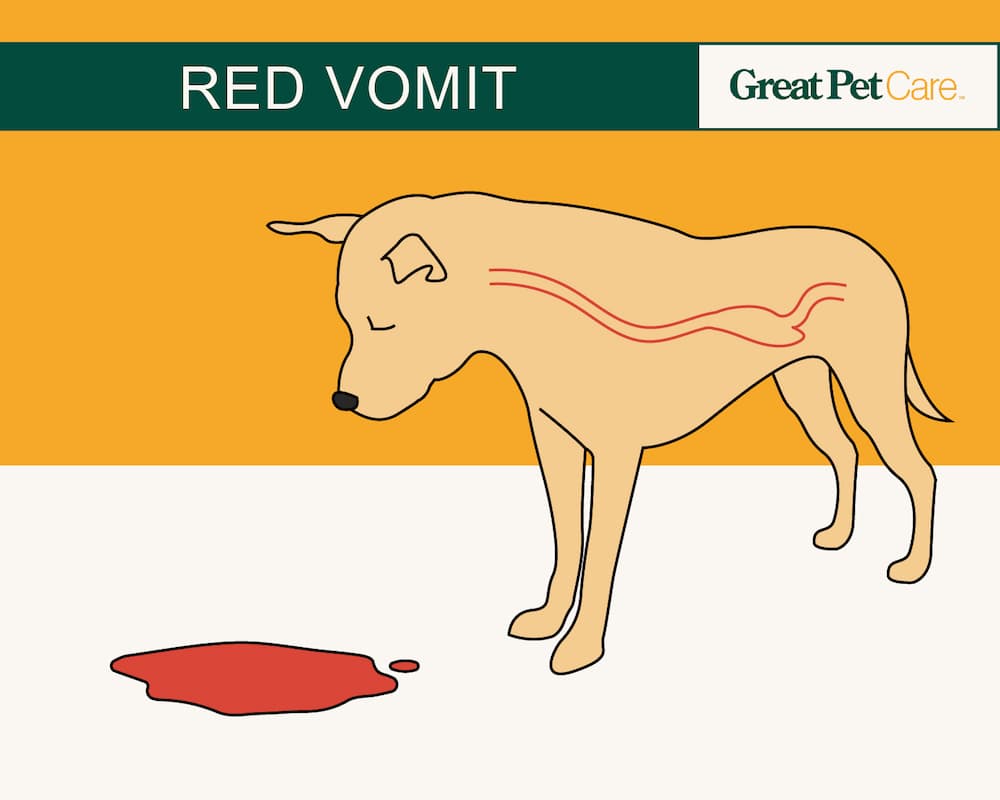Sponsored by CareCredit
Dog Vomit Color Guide: What Different Shades Mean

Watching your dog throw up is unpleasant, but it can provide valuable insights about his health. Though dog vomiting is common and oftentimes benign, it can also indicate a significant health problem.
Learning what different dog vomit colors and consistencies mean can be useful to your veterinarian. Our easy-to-understand dog vomit color guide can help with this.
If ever in doubt about what your dog’s vomit means, it’s always best to contact your veterinarian.
What Color Should Dog Vomit Be?

There really isn’t a standard dog vomit color. While it can range from brown to white-yellow, says Dr. Katie Pagan, a partner veterinarian with Heart + Paw in Fells Point, Maryland, it isn’t clear-cut. “It can absolutely vary by the dog and their diet,” she says.
Assigning definitive meanings to a particular color isn’t feasible, says Dr. Zay Satchu, chief veterinary officer and co-founder of BondVet, based in New York City. “For example, red vomit could mean blood in the vomit, or it could simply mean that a dog ate food that has a red tinge.”
Even the stuff dogs find and eat from the ground (like roadkill, food scraps, and yes, even another animal’s poop) can affect the appearance of vomit, adds Satchu.
Types of Dog Vomit

As with dog vomit colors, a dog’s diet and health factors can also cause consistency to vary, says Satchu. Here are some types of dog vomit to watch for.
Chunky Dog Vomit
When food hasn’t been properly digested, vomit appears chunky. “If the vomit looks like dog food covered up with a little bit of slime and comes up within 5 to 10 minutes after eating, we actually call that regurgitation, which can be a symptom of overeating,” says Pagan.
Liquid Dog Vomit
Dogs usually vomit liquid when their stomachs are empty, veterinarians say. Liquid dog vomit or slimy dog vomit could also mean a dog is throwing up bile, adds Pagan. This is a yellow substance produced in the liver that aids in digestion. If a dog vomits bile in the morning, it might be a case of bilious vomiting syndrome. The presence of bile can also indicate a health issue like food allergies, pancreatitis, or intestinal blockage.
Slimy Dog Vomit
Slime in vomit may mean the dog is salivating excessively, which is often caused by nausea, says Satchu. Because nausea can be a sign of any number of issues—including liver failure, heat stroke, and stress—contact your veterinarian if you’re not sure what’s causing your dog to throw up.
Foamy Dog Vomit
Foamy or frothy vomit may be associated with bile, veterinarians say. “One additional possibility is that a dog has kennel cough and is coughing up foam. This can look very similar to vomiting,” adds Satchu.
“Coffee Grounds” Dog Vomit
If your dog’s vomit resembles dark brown coffee grounds, call your veterinarian right away. Digested blood often looks like coffee grounds, so this type of vomit could indicate internal bleeding.
Dog Vomiting Vs. Regurgitation

Learning to distinguish between vomit and regurgitation can help your veterinarian figure out if there’s a concern, says Satchu. “Different medical causes can lead to each type of action, so knowing the difference can help to rule certain medical conditions in or out.”
Here are some key differences.
Dog Vomiting
Vomiting is an active process, says Satchu. “It involves retching or heaving motions. You might even see abdominal contractions during the incident.” It usually doesn’t happen immediately after eating. Vomit could be chunky, liquidy, slimy/mucusy, or foamy, adds Pagan.
Dog Regurgitation
In contrast, regurgitation is passive, says Satchu. “Food or liquid kind of “tumbles out” without retching motions.” Unlike dog vomiting, regurgitation occurs about 5 to 10 minutes after eating, says Pagan. “The food is almost always whole covered up with a little bit of slime.”
Don’t worry if you’re not able to observe the difference in real time, says Satchu. “The most important thing is getting care for your dog. But try to observe as much as possible, as certain details may help your vet figure out what’s going on.”
Dog Vomit Color Guide

While no dog vomit color chart can provide a definitive diagnosis, Satchu says color can offer important clues for your veterinarian. “Every clue can potentially be helpful, when taken in context with the larger picture, such as other symptoms your dog has and what they may have eaten.”
Follow this dog vomit color guide as a starting point for communication with your veterinarian.
Clear Liquid Dog Vomit

When dog throw up has no color or consistency, it usually means the dog’s stomach is empty, says Satchu. However, “it could also mean regurgitation of saliva, or various other possibilities.”
One of these possibilities, says Pagan, is that your dog drank his water too quickly.
White Foam Dog Vomit

White foamy dog vomit is usually tied to bile, says Pagan. “Dogs will vomit bile for many different reasons, including bilious vomiting syndrome, a foreign body, pancreatitis, or diet, just to name a few.” It could also mean the dog has an empty stomach, says Satchu.
Another possibility, she says, is that what looks like vomiting may actually be a hacking cough. “They can sound very similar, especially in dogs who have kennel cough.” A productive cough can cause your dog to bring up white, foamy fluid.
Yellow Dog Vomit

Yellow liquid could indicate bile, which Satchu says is often present in vomit, “especially when a dog vomits on an empty stomach.”
A dog who throws up yellow liquid (bile) or yellow froth after not eating for a long period of time (it usually occurs in the morning) may have a condition called bilious vomiting syndrome. Your veterinarian can help you manage this condition.
Yellow vomit can also be seen in dogs with liver disease. Watch for signs of jaundice, recommends Satchu. “Check the whites of the eyes to see if they are also yellow, which means medical care is needed right away.”
And of course, eating something yellow in color—including some types of grass—can result in yellow-tinged vomit.
Green Dog Vomit

Green colored vomit in dogs might be diet-related. “Grass is a common culprit for green,” says Satchu. It could however, also be a sign of liver and gallbladder issues, says Pagan.
Brown Dog Vomit

Brown is a common color for dog vomit, says Pagan. If the vomit resembles coffee grounds, though, she recommends contacting your veterinarian right away.
Orange Dog Vomit

If your dog is vomiting orange, it is usually diet-related, veterinarians say. However, “in some cases, blood in the vomit could appear orange when mixed with yellow coloration,” says Satchu. If you can’t pinpoint a food-related cause for orange dog vomit, it’s a good idea to schedule a visit with your veterinarian.
Red Dog Vomit

Red dog vomit could be from the red colors present in some dog foods and treats, or from another type of red-colored food the dog ate, says Satchu. However, “this could indicate blood in the vomit (bleeding in the stomach or upper intestines), so it’s never a bad idea to contact your vet team.”
Dark-Colored Dog Vomit

Very dark colored vomit in dogs (similar to the color of coffee grounds) could mean a dog is experiencing bleeding in the digestive tract, says Satchu. “But it could also simply indicate that a dog ate something dark in color, perhaps poop from another pet.”
If your dog’s vomit is dark, red, or black, veterinarians recommend contacting your veterinarian as soon as possible.
It’s always a good idea to check with your veterinarian if anything seems off, because a dog vomit color guide is just that—a guide and not a diagnosis.
Dog Vomit Colors: Which Indicates An Emergency?

Though occasional dog vomiting is common, Satchu says any of the following should prompt a call to your veterinarian.
- Blood in the vomit
- Relentless, frequent, or severe vomiting
- A possibility that your dog swallowed a toxic substance or foreign object
- Vomiting accompanied by fever, weakness, or other obvious symptoms of illness
“When in doubt, it’s best to err on the side of caution and call your vet team or take your dog in for a visit. But in general, it’s best to see the vet as soon as possible if a dog’s vomiting continues even on an empty stomach or if they have other symptoms such as a loss of appetite,” says Satchu.
If you’re unsure what your dog’s vomit color means, snap a picture for your veterinarian, recommends Pagan. While it may seem gross, a photo can help your vet understand what is going on with your dog. “We vets love seeing pictures,” she says.
General Cost to Treat Dog Vomit
The cost to treat dog vomit depends on several factors, including, but not limited to, any over-the-counter or prescription medications required, if a veterinary or emergency visit was required, and any ongoing treatments. As indicated above, a dog’s vomit color is a guide and not a diagnosis, which only a veterinarian can determine.
If the cause of vomiting is something like pancreatitis, organ failure, stroke, intestinal blockage, or something more serious, costs can be several hundred dollars or more.
For example, the cost to treat an acute bout of pancreatitis, of which vomiting is a symptom, ranges anywhere between $200 to over $2,000. It depends on your dog’s size, if hospitalization is required, and any outpatient care.
If your dog requires treatment in-house for dehydration due to acute vomiting, expect to pay for specialist or veterinarian fees, tests, intravenous fluids, and any other necessary treatments. Costs range between $300 and $1,000 depending on the testing, where you live, and if a specialist or emergency service is involved.
The last thing any pet parent wants when their dog is dealing with a health crisis is to face a large veterinary bill. While a pet health insurance plan can help offset costs, veterinary financing is another option to consider that can give you flexibility and peace of mind. For example, you can use the CareCredit credit card at veterinarian locations that accept the card to pay for emergency services, a variety of treatments, and medications your dog may need.*
*Subject to credit approval
This information is shared solely for your convenience. Neither Synchrony nor any of its affiliates, including CareCredit, make any representations or warranties regarding the products described, and no endorsement is implied. You are urged to consult with your individual veterinarian with respect to any professional advice presented.









